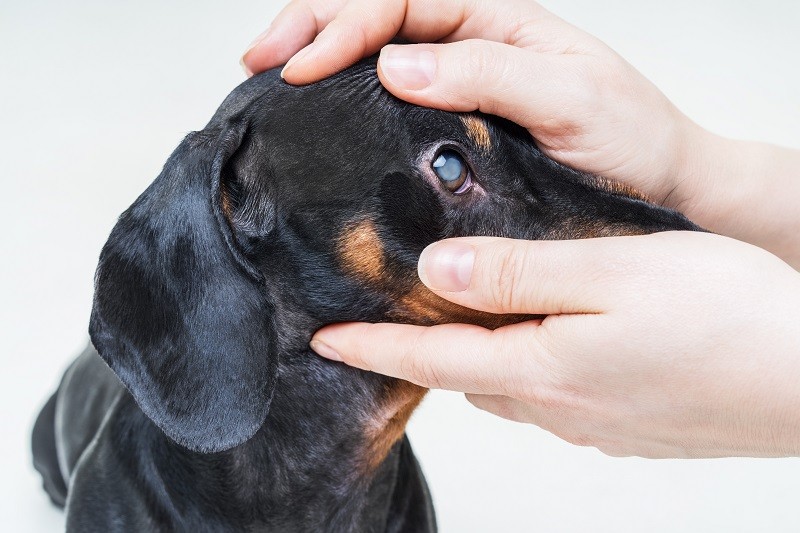
Your pet’s puppy dog eyes are irresistible, but if you’ve been gazing into your pup’s eyes and noticed that they seem a bit cloudy or irritated, things are suddenly less cute and more worrying. Eye problems are common in dogs, especially in certain breeds, some of which are minor and some of which are quite serious. But how can you tell whether your dog is suffering from a minor irritation or a blinding problem?
While taking your dog to the vet is always the best option in any situation where you fear your dog may be unwell, knowing the signs of eye issues and disorders in dogs is also highly beneficial. We’ll share 13 common eye problems dogs encounter, the signs your dog is dealing with them, and what treatment options are available. So, keep reading!

The 13 Common Eye Problems in Dogs
1. Watery Eyes (Epiphora)

| Signs: | Watery discharge, discoloration of the skin below the inner corner of the eye |
| Treatment: | Surgery, Eyedrops, medication |
Watery eyes or epiphora are exactly what they sound like—water draining from a dog’s eyes eventually causing tear stains. Some breeds, like Poodles, Maltese, or Shih Tzus suffer from this condition more often than others, usually because they are born with an abnormal drainage system. Some dogs may develop epiphora (usually unilateral) due to a blockage along the drainage route. Diagnosis in cases of watery eyes is not always straightforward and may involve tear duct examination and flushing, imaging, and even surgery.
2. Cataracts

| Signs: | Cloudy eyes, vision impairment |
| Treatment: | Surgery |
The first thing to know about cataracts is that if they are small, you may not see any obvious clouding at all. If you do see any indication of cataracts, it will be a cloudy or hazy spot in your dog’s eyes and some visual impairment, depending on the severity.
This eye problem is one of the most common causes of canine blindness, as cataracts cause the lens of the eye to become cloudy, obscuring the dog’s vision. Cataracts are often inherited, particularly in breeds such as the American Cocker Spaniel, Boston Terrier, Golden Retriever, and Poodle. However, cataracts can also be caused by aging, diabetes, injury, or a poor diet. Surgery is the only recognized way to treat cataracts, as topical medications haven’t been found to be very effective.
3. Cherry Eye

| Signs: | Pink tissue protruding from the eye’s inner corner |
| Treatment: | Surgery |
Cherry eye occurs when the tear gland on a dog’s third eyelid protrudes out of its normal location. It appears as a prolapse of pink tissue in the inner corner of the eye (hence the name of this eye issue), and while it can occur in any breed, it is commonly found in Beagles, Boxers, Pugs, and English Bulldogs among many others. When the tear gland is displaced like this, the exposed tissue gets inflamed and it can get damaged. Sometimes, the gland may go back to its normal position, but most of the time, it remains prolapsed and surgery is required to fix the problem. Even after surgery, cherry eye can return in dogs, too.
You absolutely want to take your dog to see their vet if you notice cherry eye!
4. Conjunctivitis

| Signs: | Bloodshot eyes, squinting, eye discharge, pawing at the eye |
| Treatment: | Eye drops, ointments, and sometimes oral medication |
Conjunctivitis, often known as pink eye, affects the conjunctiva of the eye (the mucosal tissue that lines the eyelids and the white of the eye), causing it to become inflamed. This inflammation can be caused by bacterial, viral, fungal, or parasitic infection or it can be triggered by allergies and immune-mediated conditions. Treatment for conjunctivitis depends on the cause, but generally speaking, it is treated with ointments, eye drops, and occasionally oral medication.
Conjunctivitis can affect the whites of the eye and the lining of the eyelids. It can be caused by irritants such as smoke or dust, a foreign body in the eye, or dry eyes. It can even appear as a sign of other diseases, so you want your pup checked out if you think they could have this.
5. Corneal Ulcers

| Signs: | Squinting, cloudiness, discharge, redness, rubbing of the eye |
| Treatment: | Topical medication, sometimes surgery |
Corneal ulcers happen when a dog’s cornea is scratched, injured, or infected. Depending on how deep the wound is, an ulcer can even lead to an eye perforation. Ulcers can be quite painful for pups, so you may find a dog with one of these rubbing at their eye or squinting. Dogs with prominent eyes, such as brachycephalic breeds, are more prone to developing corneal ulcers because they lack protection.
Treatment will consist of pain relief, antibiotics, lubricating drops, and a protective collar to avoid complications. In some cases, surgery may be needed to repair the wound. Get your pet to the vet right away if you believe they have an ulcer, so your pup won’t be in pain longer than they have to be.
6. Dry Eye

| Signs: | Inflammation, redness, occasional green or yellow discharge |
| Treatment: | Artificial tears, immuno-modulators, and others depending on the cause |
Dry eyes are self-explanatory; they happen when a dog’s eye doesn’t produce enough moisture to stay lubricated. The aqueous part of the tears is produced by the lacrimal glands. Reasons for dry eye can vary, the most common being an immune-mediated destruction of the tear gland. Other times, dogs develop dry eyes when they inherit the condition, as a side effect of medication, due to an injury, or when the nerve that innervates the gland gets damaged.
While dry eyes may seem less concerning than other eye problems in dogs, they can lead to corneal ulcers, chronic infections, corneal pigmentation, and a high level of discomfort. Typically, artificial tears are the way to go when it comes to dry eyes, but some cases may require anti-inflammatories or ointments to help.
7. Ectropion

| Signs: | Droopy or folded out bottom eyelid |
| Treatment: | Surgery, eyedrops |
Ectropion occurs when a dog’s lower eyelid droops or folds outward. This means the eyelid doesn’t come in contact with the eye much, so when a pup blinks, they aren’t creating moisture to lubricate the eye or getting rid of debris and dirt. This can lead to inflammation or infections. This eyelid problem occurs more commonly in certain dog breeds, such as Bloodhounds and Bullmastiffs.
Treatment for this issue can vary, depending on how badly the eyelid is sagging or turned outwards. When pups are still growing, it can be treated with temporary lubricating drops. However, most often, surgery is needed to correct the eyelid.
8. Entropion

| Signs: | Squinting, excess tears, redness, rubbing at eyes |
| Treatment: | Surgery |
Entropion is a condition where a dog’s eyelid rolls inward, causing the hair surrounding the eye and the eyelashes to rub against the cornea. Entropion can occur in one or both eyes and the lower or upper lids. As you can imagine, this can cause a lot of pain and result in irritation. If not treated, this condition could lead to a corneal ulcer.
The treatment for this condition is surgical to correct the problem. If the dog is very young and still developing, surgery might be postponed for a few months and your vet may recommend other temporary measures such as eyelid tacking or eyedrops.
9. Eyelid Inflammation (Blepharitis)

| Signs: | Crustiness around the eyes, yellow or green discharge, rubbing at the eyes, redness |
| Treatment: | Eye drops, oral medication |
Eyelid inflammation (blepharitis) is common in dogs and can occur as a result of allergies, parasites, bacterial infections, and immune-mediated problems among others. Infections are often bacterial, but a dog may occasionally develop a fungal infection.
Treatment for blepharitis most often requires medicated eye drops. However, if the infection is severe enough, oral medication may also be needed.
10. Glaucoma

| Signs: | Bumping into things, bulging of the eye, lethargy, pain around the eyes, watery discharge |
| Treatment: | Long-term medication, surgery |
Glaucoma occurs when the pressure inside the eye (intraocular pressure or IOP) increases. Why does the pressure increase? Typically, the fluid that is produced in the eye goes out of it to ensure a stable pressure is maintained. But with glaucoma, this balance is altered due to a drainage problem.
Glaucoma is serious and can result in blindness and potentially in the removal of a dog’s eye, so if you suspect your pup has this, you want to take them to the vet immediately. If treated early enough, medication can help reduce how much fluid is produced in the eye and increase drainage. These medications are usually given long-term. If medication doesn’t help, your ophthalmologist may recommend surgery.
11. Progressive Retinal Atrophy (PRA)

| Signs: | Night blindness, enlarged pupils, bright eyeshine |
| Treatment: | None |
Progressive retinal atrophy is a degenerative disease affecting the retina, which causes cones and rods to die off. Unfortunately, the condition is inherited, and there are often no early signs. Chances are you won’t notice anything wrong with your dog’s eyesight unless they develop night blindness, which can cause them to be nervous and extra cautious about walking around in the dark.
Even more unfortunately, there isn’t a way to treat progressive retinal atrophy. Dogs with this condition will eventually end up blind. The good news is that many pups learn to deal well with this blindness, though it will require work on your part to help get them there.
12. Uveitis

| Signs: | Cloudiness of the eye, redness, squinting, pawing at eyes |
| Treatment: | Varies |
Uveitis occurs when the internal vascular tissue of the eye (uvea) gets inflamed. The cause of internal inflammation can vary, as uveitis is usually a sign of something else occurring in the body, like an infection, a tumor, or an immune-mediated disease. Because of this, treatment for uveitis varies depending on the cause, but will always include anti-inflammatory eye drops to minimize the consequences of such inflammation. Treatment will involve treating the cause of the uveitis, as well as the inflammation itself.
13. Eye Prolapse (Proptosis)

| Signs: | Bulging eye |
| Treatment: | Dependent upon the cause of the bulging |
Proptosis is not that common in dogs, but when it occurs, it’s quite distressing and requires immediate veterinary attention. It usually occurs in dog breeds that have shallow eye orbits (sockets), such as brachycephalic dogs, and it happens as a result of trauma. Treatment always involves repositioning the eye back to its normal position as soon as possible and suturing the lids to keep it in place for 1–2 weeks. If your dog’s eye suddenly appears to bulge out when it didn’t before, it’s considered an emergency, so take your pet to the vet immediately!

Conclusion
Eye problems in canines are not uncommon. Many things can affect a dog’s eye and cause everything from irritation to blindness. As some issues are considerably worse than others, take your pup to the vet if you aren’t positive about what your dog has. Better safe than sorry!
Featured Image Credit: Angel Sallade, Shutterstock

